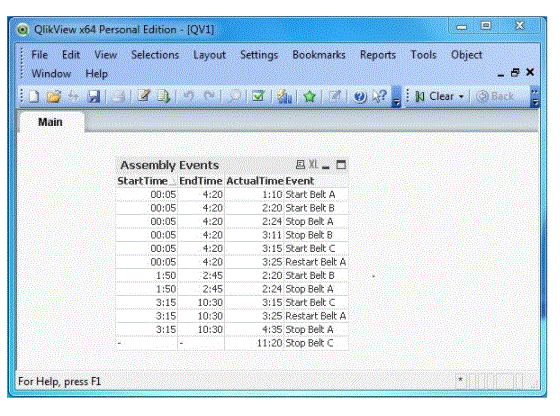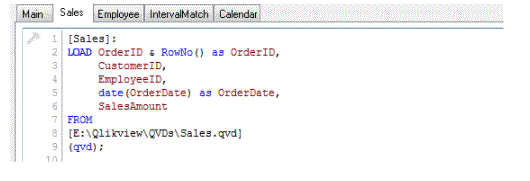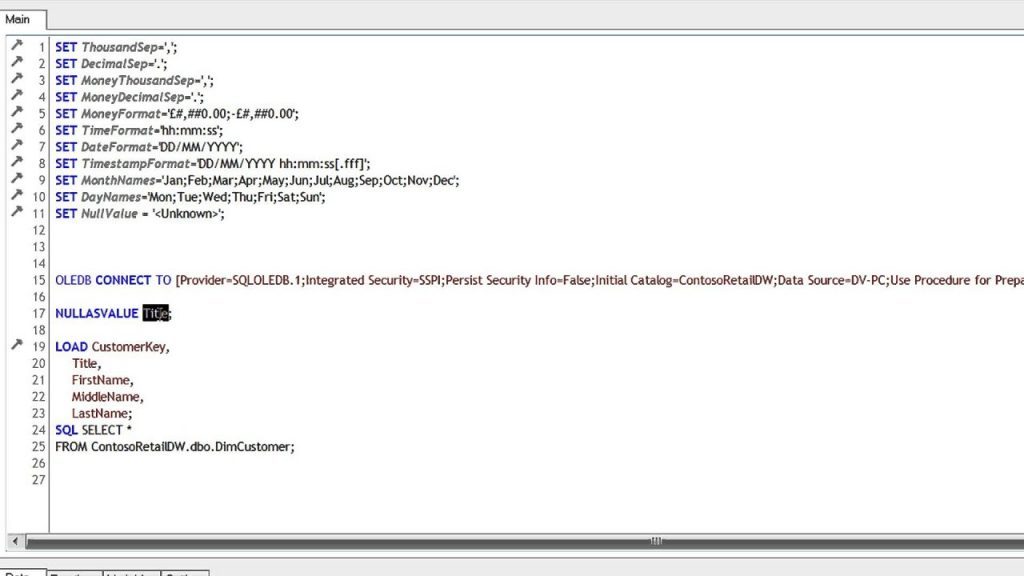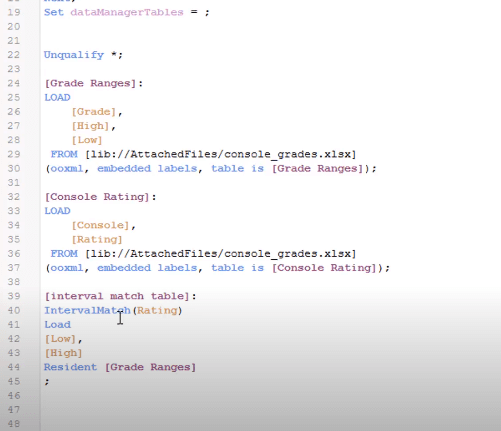
The IntervalMatch prefix is used to create a table matching discrete numeric values to one or more numeric intervals, and optionally matching the values of one or several additional keys.
- What is the IntervalMatch function in QlikView?
- Syntax of IntervalMatch Function
- IntervalMatch (Extended Syntax)
- Example of IntervalMatch Function
- How its works
- Why we use QlikView IntervalMatch?
- Implementing IntervalMatch Function in QlikView Application
- Advantages of IntervalMatch Function
- Conclusion
What is the IntervalMatch function in QlikView?
Interval Match is one of the functions in QlikView that can be used to match the number of numbers in one table, such as date, time stamp, points, percentage or any number, and the interval or length of time in the second table. The function of IntervalMatch is one or more intelligent data that changes over time. It can be used to solve the size variation by linking the correct key fields with the correct number intervals. It can also be used with LOAD, Inline and SQL statements of choice.
QlikView IntervalMatch is a tool used to compare different values and number times. It is also helpful to study how the trial took place in a formal trial. This function is useful in the assembly lines of the production house, where for a certain period of time the fixed band operation. Although, real time can happen in different places due to different problems like separation, etc. The IntervalMatch function is used with in-line statements, LOAD, and SQL Select.

Syntax of IntervalMatch Function:
IntervalMatch (match_field) (selected statement | loadstatement)
Issues: The prefix “IntervalMatch” is inserted before the statement “SELECT” or “LOAD’.
Match field: This argument includes different values that should be matched with intervals.
Key field: This argument includes additional attributes matched to translation.
Upload a statement or select a statement: This argument includes separate data points and additional keys to be uploaded to QlikView via the “IntervalMatch” Startup.

- This is a very powerful and flexible feature that can be used to link works with changing sizes over time: Slowly changing size.
- The start of the IntervalMatch should be set prior to the Load or Select loading intermittent statement.
- A table containing various data points and additional keys must have already been uploaded to QlikView prior to the IntervalMatch launch statement. Start converts the loaded table of intervals and keys in the table containing the additional column: numerical data points.
- It also expands the number of records so that a new table has one record with a possible combination of vague data point, interval and number (s) of keys.
- The selected load statement or statement should be out of the table where the first two fields contain the lower and upper limit of each period and the third and any subsequent fields contain the key (s) contained in the IntervalMatch statement.
- Intervals are always closed, i.e. end areas are included in the limit. Non-numerical constraints cause the interval to be ignored (explained).
- To avoid neglecting unspecified intervals, you may need to allow NULL values to map to other fields that form lower or higher intervals. This may be governed by the NullAsValue statement or by specific tests that replace NULL with a numerical value before or after any numerical data points.
- intervalmatch (match field, keypage1 [, keypage2, … forum5]) (upload statement | selected statement)
- a field matching field that contains numbers of different numbers that should be linked at intervals.
- keyfield (s) field fields that contain additional attributes that must be matched to conversion.
IntervalMatch (Extended Syntax):
The extended IntervalMatch prefix is used to create a table corresponding to different numerical values and intervals of one or more numbers, while simultaneously comparing the values of one or more additional keys.
- #Data Set For CpuTasks
- Star_Time End_Time TaskNo
- 01:00 5:00 Activity1
- 03:00 04:40 Activity2
- 03:45 11:00 Activity3
- #Data is set for events
- Time_Real Task
- 02:00 Start Activity1
- 02:45 Stop Work2
- 03:20 Restart Activity1
- 04:15 Stop Work1
- 02:30 Start Work3
- 03:10 Stop Work3
- 04:45 Start Work2
- 05:30 Start Work2<
- CpuTasks:
- Upload * To_Line {
- Time_first, End_ Time, Task Number
- 01:00 05:00 Activity1
- 03:00 04:40 Activity2
- 03:45 11:00 Work3};
- Jobs;
- Upload * To_Line {
- Real-time, Work
- 02:00, Start Work1
- 02:45 Stop Work1
- 03:20 Restart Activity1
- 04:15 Stop Work1
- 02:30 Start Work3
- 03:10 Stop Work3
- 04:45 Start Work2
- 05:30 Stop Work2};
- IntervalMatch (Real-Time) DOWNLOAD_Time_Start, Time_End
- CpuTasks resident;
- Star_Time End_Time Real-time activity
- 01:00 05:00 02:00 Start Work1
- 01:00 05:00 02:30 Start Work3
- 01:00 05:00 02:45 Stop Work1
- 01:00 05:00 03:10 Stop Work3
- 01:00 05:00 03:20 Restart Activity1
- 01:00 05:00 04:15 Stop Work1
- 01:00 05:00 04:45 Start Work2
- 03:00 04:40 03:10 Stop Work3
- 03:00 04:40 03:20 Restart Activity1
- 03:00 04:40 04:15 Stop Work1
- 03:45 11:00 04:15 Stop Work1
- 03:45 11:00 04:45 Start Work2
Example of IntervalMatch Function:
Let’s consider three tasks that need to be done in the CPU and that the tasks have a start and end time. We name those functions as Task1, Task2, Task3. We will now analyse the actual start time of those activities, and for that, we will take two tables:
The code above is written in the script editor as follows:
After enabling the script, we will create a Thumbnail Box object to display the data created by the IntervalMatch Task.
Data generated by the IntervalMatch Function will be displayed as follows:
How its works:
The start of the IntervalMatch must be placed before LOAD or the SELECT statement loading intermittently. The field containing the various data points (Time in the example below) and additional keys must have already been uploaded to QlikView prior to the IntervalMatch startup statement. The startup does not automatically read this field in the table of this site. Start converts the loaded table of intervals and keys in the table containing the additional column: numerical data points. It also expands the number of records so that a new table has one record with a possible combination of vague data point, interval and number (s) of keys.
Intervals may overlap and different values will be linked across the same intervals.The extended IntervalMatch prefix is used to create a table corresponding to different numerical values and intervals of one or more numbers, while simultaneously comparing the values of one or more additional keys. This is a very powerful and flexible feature that can be used to link works with changing sizes over time: Slowly changing size.
To avoid neglecting unspecified intervals, you may need to allow NULL values to map to other fields that form lower or higher intervals. This can be handled by a NullAsValue statement or by a specific test that replaces NULL values with a numerical value before or after any numerical data points

Why we use QlikView IntervalMatch?
The QlikView IntervalMatch operation is alleged to be useful as a result of it’s similarity because of the variety of numbers from either inside one table to the length of your time or intervals in another table. Also, it helps to preserve QlikView memory as you do not want recent, duplicate information to match it with this one; however , you’ll roll in the hay through this operation.
Implementing IntervalMatch Function in QlikView Application:
Steps to Applying IntervalMatch operate
1. First we are going to open the QlikView Application
2. we are going to currently open the text editor
3. when gap the text editor, we are going to improve the text victimisation IntervalMatch operate
4. When changing the text, we are going to produce a Table Sheet Item within the sheet layout window.
5. we will currently see the info generated by the IntervalMatch operate

Advantages of IntervalMatch Function:
1. Timing
IntervalMatch Saves QlikView app time as attachments can also be used.
2. Storage Memory:
Maintains QlikView Application Memory as it avoids loading all the numerical values that you may have to table these facts.
3. It avoids the concepts of case statements.
The switch control statement is a script selection construct forcing the script execution to follow different paths, depending on the value of an expression.
Conclusion
At QlikView, data is stored in tables, and this data is periodically updated. So this data is compared to the duration or interval of another table. To match the data, we will use the IntervalMatch Function. The IntervalMatch function is used in the QlikView Script to compare existing data in two tables.





